
Shelving, cupboards and racks are used for storage.
STRATEGIES FOR SMALL SPACES |
12 |
MANY PEOPLE LIVE IN APARTMENTS, units and small villas, close to major cities. It makes sense to live close to where you work, to reduce travel time, utilize public transport and generally use less energy to live.
High-density or inner-city living has its benefits and its drawbacks. Everyone needs to be comfortable, have enough space, and just enough “furniture and belongings” to make this possible.
Growing your own food in a dense urban environment can be difficult. Some people may only have a balcony to garden on, others have no such luxury. Whatever your situation, there are many strategies to better utilize the small spaces you have in your home and in the garden.
There are some general principles for being comfortable and content in our homes, and how we can change our situation to ensure this happens. How we organize our homes is best described by the acronym S2M2D2. These letters stand for storage, space, monochromatic, multifunction, de-clutter and design. Let’s examine each in turn.

Shelving, cupboards and racks are used for storage.
Small spaces and rooms seem full even with just a few pieces of furniture. Store small things, seasonal clothes, books you want to keep and some of your music collection to make the room tidy and portray the illusion of emptiness. Built-in and freestanding cupboards, shelving and stackable boxes (with lids) all enable better vertical and horizontal storage. Hooks, pegboards and racks enable objects and clothes to be hung and kept off the floor.
Concentrate on creating negative space — that area of emptiness around furniture. Chairs and tables with legs (with space underneath), mirrors and glass all amplify light and make the room seem spacious. You can look through objects to see other furniture, rather than seeing a solid wall.
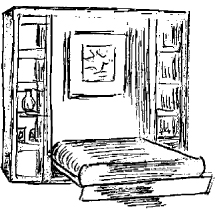
Murphy (foldaway) bed
Walls that have the same color (but maybe small changes in tone or color shade) create the illusion of space. You could probably imagine that if there was distinct contrast, such as between black and white, then the eye segregates and defines objects. When a room has shades of a similar color then the eye moves through the room uninterrupted.
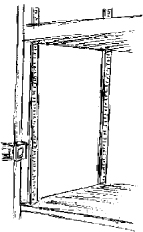
Adjustable shelves give you flexibility in storage options.
Some rooms can lend themselves to being a play room, music room, guest bedroom or office. Having a fold-up bed in the wall (Murphy bed) is far better than having a bed taking up precious space, set up on the odd chance someone might sleep over.
Multipurpose furniture also allows flexibility in how the room is filled or used. For example, a daybed enables guests to stay over, adjustable shelving enables different-sized books or objects to be stored as required, and modular furniture pieces can be rearranged or stacked.

De-clutter — put things away
Some people are hoarders. When space is at a premium then a room quickly fills with things, many of which are seldom used. Here are a few simple approaches you can adopt.
Firstly, if you haven’t used an object after about three years, then maybe it’s time for it to go. I store offcuts of materials, boxes of door handles and paint tins that only have a small amount of paint in them, all in the belief that one day these will come in handy. The truth is I’ve had these things for years, the paint tins have dried out, I never have had to replace a door handle and the offcuts are never the right size or type of material I need. Give useful things away to others or to the thrift shop. The rest can be advertized on freecycle schemes or LETS networks and recycled as much as possible, with the least amount going in the garbage.
Obviously, the time between clean-outs will vary depending on the item. You may recycle clothes after two years but keep a tent for five years or even longer.
Secondly, adopt the principle “something in, something out”. When you bring some roadside collection piece home that you simply must have, decide which object or furniture piece it replaces. If something comes into the house, then something leaves the house. Your home should be about life not stuff.
Thirdly, take the approach that if something doesn’t give you joy then maybe it should go. When you look at an object it has to make you happy — for whatever reason. If an object doesn’t bring a smile to your face or you are not content looking at it, then move it on.
Permaculture is about design, and this doesn’t just mean gardens. Houses, rooms, layouts of rooms, placement of furniture, balcony gardens and storage systems can be designed to be both functional and aesthetic. Small spaces pose particular problems, mainly because you want the most of everything in the least amount of area. Clever design helps you achieve this.
We can apply the concepts outlined in chapter 3 about designing gardens to the homes in which we live. For example, whilst “zones” are used to place elements in a garden design, we can also adopt a similar approach inside our homes.
Zone 1 (in a garden) is close to the house and we visit this area quite often. Similarly, the inside zone 1 is where you spend most of your time. The bedroom doesn’t count — we do spend a lot of time there but we are asleep. So, do you spend the majority of time sitting at the dining table, on a lounge chair, in your office (at a desk and computer) or cooking in the kitchen?
Zone 1 things are those that you use all the time, so they are often at arm’s length as you wander about the house. Zone 1 doesn’t have to be one spot but rather a pathway through the house.
Generally things have to be in your face — to see them, to use them and to look after them. So you might place jars soaking in an ice-cream container to remove their labels at the kitchen sink or windowsill so that you see them and clean them, ready for the jam you make the next day.
You are looking for a balance between chaos and calm, between clutter and clarity. We don’t need a kitchen bench full of yogurt, kefir and kombucha cultures, just enough to see when we need to act and give them some of our attention.
It’s about being organized and efficient (and energy efficient). A small table near the front door can hold your house and car keys, a water bottle, a hat, shopping bags and anything else that you need as you leave the house, so you don’t need to panic about forgetting something every time you make a journey — it’s all there ready to take.
While zone 1 is not for storage, zones 2 and 3 are. High-use things are placed in zone 2, and low-use things in zone 3. For example, a vacuum cleaner is kept at the front of a cupboard (zone 2) but winter clothes can be stored in a sealed container and placed behind the vacuum or even in a roof space (zone 3, make yourself a mini-attic).
Unfortunately, humans are reluctant to try new things. We tend to want to play it “safe,” to engage in familiar territory, to fall back on what we know and what we are comfortable with. So changing our habits can be difficult. People may have the best intentions, but change is hard to evoke and maintain. Change doesn’t happen by sheer willpower. Willpower is a highly inefficient source of energy, so we can become complacent. By this I mean that willpower isn’t really power (or energy) at all, so we often kid ourselves in thinking that we can do things whenever we want. What happens, of course, is that we stumble and put things off, so changes may start but never finish. We need ongoing motivation and positive reinforcement to continue on a path of change.
There are two components of external house features. Firstly, there is the extension of the internal, and this generally includes furniture, entertainment area and storage. Secondly, there is the garden aspect where homeowners are endeavoring to grow plants, some of which may be edible and some more aesthetic.
If you only have a balcony, then place a small table and chairs out there to enjoy the sounds of your environment and just focus on food crops. Gardening is an enjoyable hobby and growing plants and seeing them mature is rewarding in itself. Harvesting and eating them afterwards is a bonus.
If you have a little more room then typically you might have a small shed where you can keep the barbecue, a few tools and items you occasionally use such as tents, bags, beach umbrellas and fold-up chairs. Unclutter the house by storing outside in a weatherproof shed or enclosure.
There are many ways you can utilize a small space to grow plants, and there are many techniques to enable you to grow plants densely. The basic premise is: no space is too small for a garden. Here are some ideas to help you with the design of your intensive garden oasis. None of these strategies are specifically for small spaces and they can be applied in all gardens, but they can work well in small, challenging gardens.
Plants with different growth rates and habits can be planted very close to each other. This is a type of intense gardening to create a vegetable polyculture. So fast-growing greens (e.g. radishes and lettuces) are planted alongside slow-growing brassicas (e.g. broccoli and cabbage) and onions. The radishes mature early, followed by lettuces. These can be harvested in turn, whilst the other food crops continue to grow. Brassicas are picked next and then finally the onions (as these mature last).

Stacking — closely-packed plants that may also mature at different times
You might have a dwarf fruit tree in a pot and you could easily plant a range of vegetables and herbs, all with different heights and spreads, as under story. Stack this altogether but ensure each has adequate sunlight and sufficient space as they grow.
The secret is to harvest some plants when they are young (as a method to thin crops), not when they are mature. You also need a balance of root and leaf crops. Avoid too many of the larger fruits such as tomatoes, as these will shade out others. Generally remove a whole plant to thin, as this creates gaps to place more seed and allows the growth and development of nearby plants to occur.
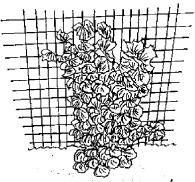
Vertical gardening using a trellis…

… and using pots
This is mainly used for vine type crops such as peas, beans, melons and even tomatoes. Trellises, various wooden or steel frames, rows of wires fixed to a wall and wire mesh can all be used as the support structure for spreading plants.
Many plants, including fruit trees, can be grown in large pots. These can be moved around a balcony or small courtyard to catch the sun as required. Vegetables, flowers and companion plants can be grown under the fruit tree and picked or clipped when needed.
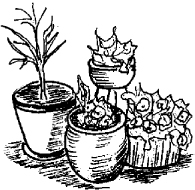
Gardening with pots
Make sure that the pot and mature plant will not be too heavy and awkward to move. Furthermore, when plants are watered the weight of the soil increases so don’t put any large pots on balconies that you suspect may not be able to support that weight. You might be able to place large pots on a platform or flatbed trolley with caster wheels to enable it to be pushed around from one space to another without injuring your back.
Picking greens can be grown in foam boxes or similar containers, as long as there are holes in the bottom to enable drainage of excess water. Don’t forget to top up the pot or garden bed with new soil each season and to fertilize regularly.
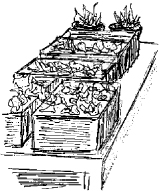
Container gardening
These are containers, usually long, rectangular and only about 12 in deep. These containers are mounted in front of, and below, a window outside the house, so that vegetation and color (window boxes are also called flower boxes) can be seen as you look out the window. Window boxes are mini gardens that enable you to bring the outside in. They also make a decorative feature and brighten an otherwise drab exterior wall.
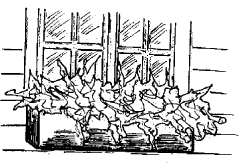
Window box
There are a few variations of this technique. You could plant a number of varieties of say tomatoes where each matures at different times (early, mid and late varieties), so the availability of tomatoes is extended over a longer time.
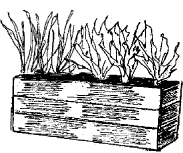
A raised garden bed
Secondly, you can start with one crop and then before it is finished plant the same type again (or plant seeds one month apart over a few months).
This “succession in time” idea was developed by Masanobu Fukuoka in Japan and is now practiced throughout the world. Suitable plants to use are lettuce, spinach and radish, which all have long growing seasons but can be harvested within weeks in some cases (or at least some leaves can).

Wicking bed — a self-watering garden bed that is ideal when normal irrigation is not available
These can be made in varying heights, so that growth is staggered vertically. Plants in the lower beds shouldn’t reduce sunlight access to taller beds, and vice versa. The beds themselves can be just 1 ft wide, although bought steel beds are usually wider than 2 ft as steel crimps when bent too tightly.
Wicking beds may be a useful strategy in some situations. These have a base or container at the bottom to hold water. Water moves up by capillary action to make the soil moist, enabling plants to access moisture as required.
You can lengthen the growing season of your plants by changing the surrounding microclimate. Typically, this is done by providing protection from excess sun, wind and frost.

Cloche — a cover over growing plants
You can do this by placing your plants in a cold frame or covering them with clear plastic or some other membrane to trap heat. If your plants are exposed to too much sunlight then placing shadecloth over them reduces their stress.

Plastic or glass cover for individual plants
If your garden space or balcony is in full sun for most of the day, then sun-loving varieties such as tomatoes, rosemary and peppers will thrive.
However, if you have shade for a large part of the day then plant shade-tolerant species such as silverbeet, lettuce and many other “greens.” If you have pots or small containers then move these around to exploit the sun, or shelter from it.
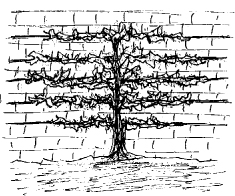
Espalier fruit trees on walls that have a sunny aspect.
Try a mix of perennials and annuals. Most vegetables are annuals but a few are semi-perennial such as rhubarb, globe artichoke and asparagus. These either naturally die back in winter or are cut back deliberately, regrowing in spring or early the following year.
Endeavor to find out what plants grow well in your area, determine what foods you like to eat or are willing to try and then stick with these.
Don’t grow too many of one type as you will just have too many tomatoes — one plant is ample. Variety is the key, so plant only a few of each vegetable type and choose varieties that are hardy and productive.

Block planting
Rather than spreading your lettuce seedlings throughout a bed, simply plant them all together in a block. These can then be plucked and thinned as they grow. You do use less space when a group of the same plants are grown like this.
Beetroots, onions and carrots can be planted in blocks, and you can try to see if this technique works for the other vegetables you like to grow. Square foot gardening is a variation of this idea.
These are also known as green walls or vertical gardens, and many are hydroponic setups that use little or no soil. Plants are suspended in an inert, loose fiber or spongy-block media. Pots or containers, full of media and plants, are suspended in a frame. Irrigation pipework is interwoven throughout the frame to water the plants. Some of these pot setups are like mini wicking beds and have a small reservoir of water to supply plant roots.
As an alternative use a recycled plastic or wooden pallet (wood tends to rot though), fix to a wall, line with shadecloth and fill with soil. Where you want to plant, cut the shadecloth away and carefully place your seedling into the soil. This is easy for seedlings, very difficult for mature plants.
Before you start fixing trellises or living walls, make sure you have permission from your landlord.
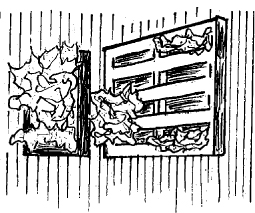
A living wall from recycled pallets.
Not only can you grow from the floor upwards, you can hang pots and baskets from the ceiling downwards. Depending on the height you have above you, several baskets can be suspended one under another. Water applied to the top one filters downwards into the next basket.

Hanging baskets can contain rampant plants.
Hanging baskets can be traditional fiber-lined wire mesh types or you can use sections of cut-in-half plastic sewer pipe or gutters with the ends capped.
Picking greens such as lettuces, chives and spinach thrive in baskets, while strawberries and mint can be contained and allowed to cascade over the edge. Potted color adds variety and aesthetics (who doesn’t like seeing colorful flowers?) so mix ornamentals with food crops. Hanging baskets can dry out quickly in warmer weather so make sure you monitor moisture levels and irrigate or hand-water frequently.
Various waterwise techniques are outlined in chapter 10. When you only have a small space then large impact sprinklers are not really suitable. Wicking beds are self-watering, but you still need to top them up once a week or so.
You may be able to set up a small reticulation system, with a controller and solenoids, if you have some garden area on the ground, but if you are balcony-gardening then hand-watering is probably the only option. Buy a watering can and keep it nearby.
Reticulation systems should incorporate dripline irrigation, and watering should be undertaken meeting local guidelines and enforcing any local restrictions (certain days, times of the day, duration).
It is always a good idea to consider drainage when watering on balconies, especially as water comes out at the bottom of a pot or garden bed and can pool on the balcony. Ensure that excess water can drain away safely and not drip below onto your neighbor’s property.
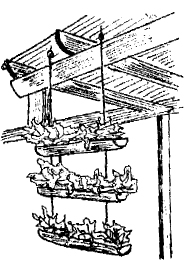
Use old gutter or PVC pipes to make vertical hanging baskets.
How to compost organic waste is discussed in detail in chapter 4. Even in a small space you should endeavor to place your food scraps in a compost bin, a bokashi bucket or a worm farm. Materials generated from these systems are ideal to reuse in the garden and will provide fertilizer and mulch for your plants.
Composting leaf material and prunings from plants may be possible but you generally need a large space for this to occur properly. Compost bins can be used to store materials but they only ever produce a cold compost themselves.
Additionally, you may find vermin (including insects, spiders, rats and mice) are attracted to the free food and shelter you are providing for them.
You can adjust and live anywhere in the world provided you are happy in that space. Make it your own. Put your favorite things in view, or move them around occasionally, so you can see and appreciate them.
Change the setting by displaying stored items and storing others you may have tired of. People tend to fill large spaces with more possessions, so living in small spaces can be a great way to reevaluate your “stuff” both on a physical and an emotional level.
Keeping a small space neat and tidy, especially the kitchen and other work areas, is essential as small messes tend to morph into large messes. And whenever and wherever you can, garden and grow food.